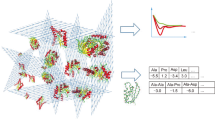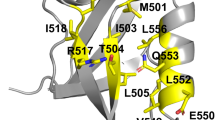Abstract
Computational protein sequence design is the rational design based on computer simulation of new protein molecules to fold to target three-dimensional structures, with the ultimate goal of designing novel functions. It requires a good understanding of the thermodynamic equilibrium properties of the protein of interest. Here, we consider the contribution of the solvent to the stability of the protein. We describe implicit solvent models, focusing on approximations of their nonpolar components using geometric potentials. We consider the surface area (SA) model in which the nonpolar solvation free energy is expressed as a sum of the contributions of all atoms, assumed to be proportional to their accessible surface areas (ASAs). We briefly review existing numerical and analytical approaches that compute the ASA. We describe in more detail the alpha shape theory as it provides a unifying mathematical framework that enables the analytical calculations of the surface area of a macromolecule represented as a union of balls.
Access this chapter
Tax calculation will be finalised at checkout
Purchases are for personal use only
Similar content being viewed by others
References
The UniProt Consortium (2015) UniProt: a hub for protein information. Nucleic Acids Res 43:D204–D212
Berman HM, Westbrook J, Feng Z, Gilliland G, Bhat TN, Weissig H (2000) The Protein Data Bank. Nucleic Acids Res 28:235–242
Dror RO, Dirks RM, Grossman JP, Xu H, Shaw DE (2012) Biomolecular simulation: a computational microscope for molecular biology. Annu Rev Biophys 41:429–452
Koehl P, Levitt M (1999) A brighter future for protein structure prediction. Nat Struct Biol 6:108–111
Friesner RA, Abel R, Goldfeld DA, Miller EB, Murrett CS (2013) Computational methods for high resolution prediction and refinement of protein structures. Curr Opin Struct Biol 23:177–184
Jothi A (2012) Principles, challenges and advances in ab initio protein structure prediction. Protein Pept Lett 19:1194–1204
Lindorff-Larsen K, Piana S, Dror RO, Shaw DE (2011) How fast-folding proteins fold. Science 334:517–520
Piana S, Lindorff-Larsen K, Shaw DE (2013) Atomic-level description of ubiquitin folding. Proc Natl Acad Sci U S A 110:5915–5920
Nguyen H, Maier J, Huang H, Perrone V, Simmerling C (2014) Forlding simulations for proteins with diverse topologies are accessible in days with a physics-based force field and implicit solvent. J Am Chem Soc 136:13959–13962
Drexler KE (1981) Molecular engineering: an approach to the development of general capabilities for molecular manipulation. Proc Natl Acad Sci U S A 78:5275–5278
Pabo C (1983) Designing proteins and peptides. Nature (London) 301:200
Khoury GA, Smadbeck J, Kieslich CA, Floudas CA (2014) Protein folding and de novo protein design for biotechnological applications. Trends Biotechnol 32:99–109
Kiss G, Celebi-Olcum N, Moretti R, Baker D, Houk KN (2013) Computational enzyme design. Angew Chem 52:5700–5725
Pantazes RJ, Grisewood MJ, Maranas CD (2011) Recent advances in computational protein design. Curr Opin Struct Biol 21:467–472
Strauch EM, Fleishman SJ, Baker D (2014) Computational design of a pH-sensitive IgG binding protein. Proc Natl Acad Sci U S A 111:675–680
Damborsky J, Brezovsky J (2014) Computational tools for designing and engineering enzymes. Curr Opin Chem Biol 19:8–16
King NP, Bale JB, Sheffler W, McNamara DE, Gonen S, Gonen T, Yeates TO, Baker D (2014) Accurate design of co-assembling multi-component protein nanomaterials. Nature (London) 510:103–108
Lai Y-T, Reading E, Hura GL, Tsai K-L, Laganowsky A, Asturias FJ, Tainer JA, Robinson CV, Yeates TO (2014) Structure of a designed protein cage that self-assembles into a highly porous cube. Nat Chem 6:1065–1071
Gogonea V, Suarez D, van der Vaart A, Merz KM Jr (2001) New developments in applying quantum mechanics to proteins. Curr Opin Struct Biol 11:217–223
Raha K, Peters MB, Wang B, Yu N, Wollacott AM, Westerhoff LM, Merz KM Jr (2007) The role of quantum mechanics in structure-based drug design. Drug Discov Today 12:725–731
Li Z, Yang Y, Zhan J, Dai L, Zhou Y (2013) Energy functions in de novo protein design: current challenges and future prospects. Annu Rev Biophys 42:315–335
Eisenberg D, McLachlan A (1986) Solvation energy in protein folding and binding. Nature (London) 319:199–203
Richards FM (1977) Areas; volumes; packing; and protein-structure. Annu Rev Biophys Bioeng 6:151–176
Lum K, Chandler D, Weeks JD (1999) Hydrophobicity at small and large length scales. J Phys Chem B 103:4570–4577
Lee B, Richards FM (1971) Interpretation of protein structures: estimation of static accessibility. J Mol Biol 55:379–400
Shrake A, Rupley J (1973) Environment and exposure to solvent of protein atoms in lyzozyme and insulin. J Mol Biol 79:351–371
Legrand SM, Merz KM (1993) Rapid approximation to molecular-surface area via the use of Boolean logic and look-up tables. J Comput Chem 14:349–352
Wang H, Levinthal C (1991) A vectorized algorithm for calculating the accessible surface area of macromolecules. J Comput Chem 12:868–871
Futamura N, Alura S, Ranjan D, Hariharan B (2004) Efficient parallel algorithms for solvent accessible surface area of proteins. IEEE Trans Parallel Dist Syst 13:544–555
Wodak SJ, Janin J (1980) Analytical approximation to the accessible surface-area of proteins. Proc Natl Acad Sci U S A 77:1736–1740
Cavallo L, Kleinjung J, Fraternali F (2003) POPS: a fast algorithm for solvent accessible surface areas at atomic and residue level. Nucleic Acids Res 31:3364–3366
Street AG, Mayo SL (1998) Pairwise calculation of protein solvent-accessible surface areas. Fold Des 3:253–258
Connolly M (1983) Analytical molecular surface calculation. J Appl Cryst 16:548–558
Richmond TJ (1984) Solvent accessible surface-area and excluded volume in proteins. Analytical equations for overlapping spheres and implications for the hydrophobic effect. J Mol Biol 178:63–89
Dodd L, Theodorou D (1991) Analytical treatment of the volume and surface area of molecules formed by an arbitrary collection of unequal spheres intersected by planes. Mol Phys 72:1313–1345
Irisa M (1996) An elegant algorithm of the analytical calculation for the volume of fused spheres with different radii. Comput Phys Commun 98:317–338
Gibson K, Scheraga H (1987) Exact calculation of the volume and surface area of fused hard-sphere molecules with unequal atomic radii. Mol Phys 62:1247–1265
Kratky KW (1978) Area of intersection of n equal circular disks. J Phys A Math Gen 11:1017–1024
Edelsbrunner H (1995) The union of balls and its dual shape. Discrete Comput Geom 13:415–440
Mach P, Koehl P (2011) Geometric measures of large biomolecules: surface, volume, and pockets. J Comput Chem 32:3023–3038
Li J, Mach P, Koehl P (2013) Measuring the shapes of macromolecules – and why it matters. Comput Struct Biotechnol J 8:e201309001
Bondi A (1964) vdW volumes and radii. J Phys Chem 68:441–451
Rowland RS, Taylor R (1996) Intermolecular non-bonded contact distances in organic crystal structures: comparison with distances expected from vdW radii. J Phys Chem 100:7384–7391
Tsai J, Taylor R, Chothia C, Gerstein M (1999) The packing density in proteins: standard radii and volumes. J Mol Biol 290:253–266
Chothia C (1975) Structural invariants in protein folding. Nature (London) 254:304–308
Fauchere J-L, Pliska V (1983) Hydrophobic parameters of amino acid side-chains from the partitioning of N-acetyl-amino-acid amides. Eur J Med Chem Chim Ther 18:369–375
Sharp KA, Nicholls A, Friedman R, Honig B (1991) Extracting hydrophobic free energies from experimental data : relationship to protein folding and theoretical models. Biochemistry 30:9686–9687
Holtzer A (1992) The use of Flory-Huggins theory in interpretating partitioning of solutes between organic liquids and water. Biopolymers 32:711–715
Koehl P, Delarue M (1994) Polar and non polar atomic environment in the protein core: implications for folding and binding. Proteins 20:264–278
Edelsbrunner H, Mucke EP (1994) Three-dimensional alpha shapes. ACM Trans Graph 13:43–72
Edelsbrunner H, Fu P (1994) Measuring space filling diagrams and voids (UIUC-BI-MB-94-01)
Edelsbrunner H, Shah NR (1996) Incremental topological flipping works for regular triangulations. Algorithmica 15:223–241
Mucke EP, Saias I, Zhu B (1999) Fast randomized point location without preprocessing in two- and three-dimensional Delaunay triangulations. Comput Geom Theor Appl 12:63–83
Edelsbrunner H (1992) Weighted alpha shapes (UIUC-CS-R-92-1760)
Edelsbrunner H, Facello MA, Liang J (1998) On the definition and construction of pockets in macromolecules. Discrete Appl Math 88:83–102
Liang J, Edelsbrunner H, Fu P, Sudhakar PV, Subramaniam S (1998) Analytical shape computation of macromolecules. II. Inaccessible cavities in proteins. Proteins 33:18–29
Liang J, Edelsbrunner H, Woodward C (1998) Anatomy of protein pockets and cavities: measurement of binding site geometry and implications for ligand design. Protein Sci 7:1884–1897
Petitjean M (1994) On the analytical calculation of Van der Waals surfaces and volumes: some numerical aspects. J Comput Chem 15:507–523
Fraternali F, Cavallo L (2002) Parameter optimized surfaces (POPS): analysis of key interactions and conformational changes in the ribosome. Nucleic Acids Res 30:2950–2960
Acknowledgment
Patrice Koehl acknowledges support from the Ministry of Education of Singapore through Grant Number: MOE2012-T3-1-008.
Author information
Authors and Affiliations
Corresponding author
Editor information
Editors and Affiliations
Rights and permissions
Copyright information
© 2017 Springer Science+Business Media New York
About this protocol
Cite this protocol
Li, J., Koehl, P. (2017). Geometric Potentials for Computational Protein Sequence Design. In: Samish, I. (eds) Computational Protein Design. Methods in Molecular Biology, vol 1529. Humana Press, New York, NY. https://doi.org/10.1007/978-1-4939-6637-0_5
Download citation
DOI: https://doi.org/10.1007/978-1-4939-6637-0_5
Published:
Publisher Name: Humana Press, New York, NY
Print ISBN: 978-1-4939-6635-6
Online ISBN: 978-1-4939-6637-0
eBook Packages: Springer Protocols




